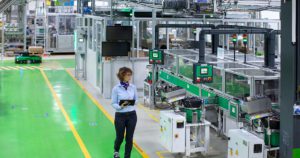Modern building management systems (BMS) enable superior integration between smart systems ̶ including operations technology (OT) and information technology (IT) systems. They also maintain specifications for heating, cooling, and ventilation, monitor independent power supplies, and support energy conservation and emergency response procedures.

We at T.M. Bier & Associates ̶ a New York City area-based Schneider Electric EcoXpert partner specializing in the design, installation, and integration of HVAC, lighting, security, and building automation ̶ are often asked to consult with building owners on the best ways to upgrade their existing building management systems (BMS).
For many building owners, the prospect of retrofitting their aging BMS is stressful. They know that they’ll have to shut down big air handling units or chillers, cooling towers, and/or pumps to make the change from one set of building controls to the next. Such actions, if poorly planned, can disrupt tenants and generate more downtime costs than expected.
Key indicators that should drive building management system changes
One of the biggest questions that comes up for many building owners is knowing when the time is right to invest in a building management system upgrade. We’ve compiled a quick list of some change indicators to look for.
Indicator #1. Serviceability of current building management system becomes more problematic
One of our Manhattan-based customers has had the same building management system in place for over 30 years. The controllers installed in this location were discontinued by the manufacturer several years ago. They can no longer buy compatible new controllers from the manufacturer, nor can they find anyone to service their existing controllers. If the system experiences a major failure, they’re likely to lose most if not all their tenants. They are confronted with an ongoing level of high risk and cost effectively maintaining their building management system is no longer an option.
Even locations that have not yet reached such an extreme situation can suffer from elevated maintenance costs that continue to increase over time as the building management system ages. They also tend to experience more frequent and longer instances of downtime. These are all clear warning signs that an immediate upgrade is needed.
Indicator #2. Declining marketability of your facility
In today’s marketplace, many large and medium-size building tenants pay specialized consultants to go in and closely investigate a property before they sign a lease. They want to know the detailed history of building infrastructure improvements. They are also interested in the status of the air conditioning, ventilation, and lighting systems. The building management system is a big part of this evaluation because they know it is a key indicator of tenant comfort, indoor air quality, temperature control, and energy consumption. Buildings with antiquated building management systems are likely to quickly drop from the list of tenant building prospects under consideration.
Newer building management system systems also make a building smarter and help the building to offer features that attract a younger workforce to a more modern digital workplace. Amenities such as optical recognition for entry into spaces and lights and shades that automatically dim to save energy and optimize lighting comfort help to drive demand. An updated building management system is key to smart building operation and can help landlords maintain a higher price per square foot.
Indicator #3. Availability of existing financial incentives for new building management systems
Over the last several years, more aggressive utility incentives and rebates have been made available to building owners. Several years ago, a utility or government-affiliated entity would fund 10% to 20% of a building management system installation project. But now, we are seeing funding rates of 50% to 70% of the entire building management system project. These programs tend to be offered on a temporary basis and, if modernization is delayed, then building owners may miss this substantial funding option and may have to wait years until the next cycle of funding is made available. At T.M. Bier we are familiar with these programs and have extensive experience advising building owners on how to take full advantage of these and other financial incentives.
For more information
Across many buildings today, an increased risk of failure of building management systems and the mechanical and power equipment they control is simply not acceptable. In a financial brokerage firm, for example, the disruption of the building infrastructure power systems can impact the core business and result in staggering downtime-induced financial losses. While in a hospital, the impact can affect patient outcome. This is especially true in critical care areas like operating rooms where a reliable supply of clean, purified air is crucial.
Building management system installations should be built on excellent products. And more importantly, they should be backed by a strong partner who knows how to install and support the BMS. Look for a partner who:
- Has extensive installation experience and knowledge
- Offers a dedicated and responsive staff
- Delivers a full range of support throughout the installation
- Provides service and maintenance capabilities long after the installation is complete.
When investing in a BMS upgrade, the brand of system selected can also make a big difference as to how long that system can provide reliable service. Consider that some brands will only support their installed controllers for five or six years whereas other manufacturers, like Schneider Electric, maintain their controllers for much longer periods of time. Brands with shorter coverage periods will force building owners to consider upgrading sooner or face an increased risk of downtime. Component and software reliability, innovation, and longevity all play an important role in helping building owners to decide on the right time to upgrade their BMS.
To learn more about how and when to upgrade and enhance smart building performance, visit us at T.M. Bier & Associates or consult the Schneider Electric web pages.
 |
Schneider Electric has been recognized as the world’s most sustainable corporation in 2021 by Corporate Knights Global 100 Index. |
EcoXpert Partner Program
Interested in learning about the EcoXpert Partner Program? Visit the EcoXpert website for more details about the benefits of our business partners program.
Learn more about T.M. Bier & Associates, Inc.
T.M. Bier & Associates, Inc. (TMBA) was established in 1977 in Long Island, NY. Since that time, the company has grown into the metropolitan New York area’s most prominent independent automated building management systems engineering company. The design & installation of HVAC systems, lighting controls systems, security systems & various industrial controls is only part of the solution that T.M. Bier provides to its clients.
T.M. Bier uses the most advanced technology on the market in the design, installation, monitoring, and service of HVAC systems & controls, lighting controls, security systems, and various industrial controls.
TMBA offers building automation systems engineering solutions and high-quality services backed by decades of experience; the type of experience that many prestigious properties in the Northeast have relied on.
T.M. Bier is a Master-level BMS EcoXpert and is also certified as an Access Control EcoXpert.



